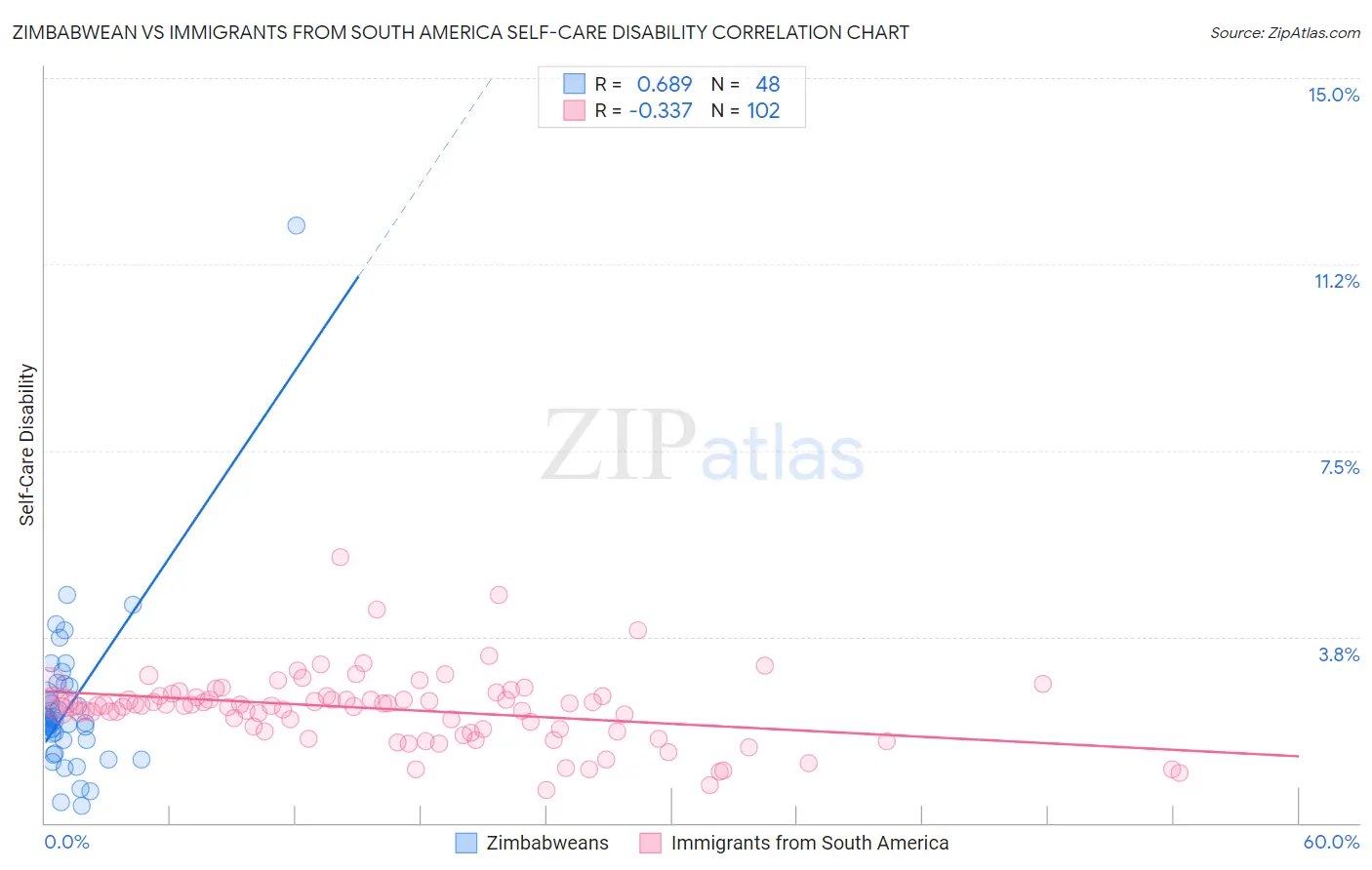Zimbabwean vs Immigrants from South America Self-Care Disability
COMPARE
Zimbabwean
Immigrants from South America
Self-Care Disability
Self-Care Disability Comparison
Zimbabweans
Immigrants from South America
2.2%
SELF-CARE DISABILITY
100.0/ 100
METRIC RATING
5th/ 347
METRIC RANK
2.4%
SELF-CARE DISABILITY
88.8/ 100
METRIC RATING
132nd/ 347
METRIC RANK
Zimbabwean vs Immigrants from South America Self-Care Disability Correlation Chart
The statistical analysis conducted on geographies consisting of 69,189,225 people shows a significant positive correlation between the proportion of Zimbabweans and percentage of population with self-care disability in the United States with a correlation coefficient (R) of 0.689 and weighted average of 2.2%. Similarly, the statistical analysis conducted on geographies consisting of 485,509,375 people shows a mild negative correlation between the proportion of Immigrants from South America and percentage of population with self-care disability in the United States with a correlation coefficient (R) of -0.337 and weighted average of 2.4%, a difference of 11.9%.

Self-Care Disability Correlation Summary
| Measurement | Zimbabwean | Immigrants from South America |
| Minimum | 0.34% | 0.67% |
| Maximum | 12.0% | 5.3% |
| Range | 11.7% | 4.7% |
| Mean | 2.4% | 2.3% |
| Median | 2.0% | 2.4% |
| Interquartile 25% (IQ1) | 1.7% | 1.8% |
| Interquartile 75% (IQ3) | 2.7% | 2.5% |
| Interquartile Range (IQR) | 1.0% | 0.70% |
| Standard Deviation (Sample) | 1.7% | 0.73% |
| Standard Deviation (Population) | 1.7% | 0.73% |
Similar Demographics by Self-Care Disability
Demographics Similar to Zimbabweans by Self-Care Disability
In terms of self-care disability, the demographic groups most similar to Zimbabweans are Filipino (2.2%, a difference of 0.25%), Immigrants from Bolivia (2.2%, a difference of 0.46%), Bolivian (2.2%, a difference of 0.51%), Immigrants from Nepal (2.2%, a difference of 0.64%), and Immigrants from Singapore (2.1%, a difference of 0.98%).
| Demographics | Rating | Rank | Self-Care Disability |
| Yup'ik | 100.0 /100 | #1 | Exceptional 1.9% |
| Immigrants | India | 100.0 /100 | #2 | Exceptional 2.0% |
| Thais | 100.0 /100 | #3 | Exceptional 2.1% |
| Immigrants | Singapore | 100.0 /100 | #4 | Exceptional 2.1% |
| Zimbabweans | 100.0 /100 | #5 | Exceptional 2.2% |
| Filipinos | 100.0 /100 | #6 | Exceptional 2.2% |
| Immigrants | Bolivia | 100.0 /100 | #7 | Exceptional 2.2% |
| Bolivians | 100.0 /100 | #8 | Exceptional 2.2% |
| Immigrants | Nepal | 100.0 /100 | #9 | Exceptional 2.2% |
| Sudanese | 100.0 /100 | #10 | Exceptional 2.2% |
| Immigrants | South Central Asia | 100.0 /100 | #11 | Exceptional 2.2% |
| Immigrants | Ethiopia | 100.0 /100 | #12 | Exceptional 2.2% |
| Ethiopians | 100.0 /100 | #13 | Exceptional 2.2% |
| Luxembourgers | 100.0 /100 | #14 | Exceptional 2.2% |
| Okinawans | 100.0 /100 | #15 | Exceptional 2.2% |
Demographics Similar to Immigrants from South America by Self-Care Disability
In terms of self-care disability, the demographic groups most similar to Immigrants from South America are Polish (2.4%, a difference of 0.010%), Immigrants from Austria (2.4%, a difference of 0.030%), Immigrants from Colombia (2.4%, a difference of 0.030%), Immigrants from Romania (2.4%, a difference of 0.050%), and Russian (2.4%, a difference of 0.070%).
| Demographics | Rating | Rank | Self-Care Disability |
| Hmong | 89.9 /100 | #126 | Excellent 2.4% |
| Colombians | 89.7 /100 | #127 | Excellent 2.4% |
| Immigrants | Hungary | 89.6 /100 | #128 | Excellent 2.4% |
| Immigrants | Romania | 89.3 /100 | #129 | Excellent 2.4% |
| Immigrants | Austria | 89.0 /100 | #130 | Excellent 2.4% |
| Poles | 88.9 /100 | #131 | Excellent 2.4% |
| Immigrants | South America | 88.8 /100 | #132 | Excellent 2.4% |
| Immigrants | Colombia | 88.5 /100 | #133 | Excellent 2.4% |
| Russians | 88.2 /100 | #134 | Excellent 2.4% |
| Laotians | 87.8 /100 | #135 | Excellent 2.4% |
| South American Indians | 87.2 /100 | #136 | Excellent 2.4% |
| Austrians | 87.0 /100 | #137 | Excellent 2.4% |
| Immigrants | Croatia | 86.6 /100 | #138 | Excellent 2.4% |
| Sri Lankans | 86.6 /100 | #139 | Excellent 2.4% |